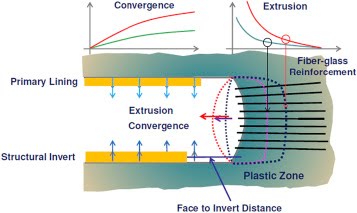Face dowels (ground improvement for tunnel excavation)
Fiberglass dowels are used widely to stabilize the poor ground for excavating tunnels. Face dowels are installed over the cross-section of the tunnel. Fiberglass reinforcement can be used to reinforce the excavated area. Fiberglass dowels installed in predrilled holes then injected with cement mortar. Dowels used to strengthen the face of the tunnel should be made from a material that can be easily excavated. Fiberglass reinforcement can be excavated easily. Using of fiberglass reinforcement will be suitable when TBM or road header used to excavate the tunnel as they can be easily excavated and removed. However, the using of fiberglass dowels for other methods of excavation may pose a risk because fiberglass is a brittle material. The breaking of fiberglass will produce potentially dangerous sharp edges, which may affect the safety of workers.
Steel dowels can be used in a similar manner to stabilize weak grounds for tunnel construction. During the excavation, all safety measures should be taken to prevent any accidents, dealing with steel dowels or fiberglass dowels should be with the highest attention. Steel dowels can be cut easily using a handheld cutter. Face dowels should provide continuous stability of soil as the excavation advanced. As the excavation advancing the length of dowels will be shortened by cutting the steel dowels or breaking of fiberglass dowels. Once the shortened length of dowels reaches the minimum length, new set dowels should be installed at the tunnel and overlapped with old dowels. Usually, the overlapping length is a few meters.
Figure 1
Steel dowels can be used in a similar manner to stabilize weak grounds for tunnel construction. During the excavation, all safety measures should be taken to prevent any accidents, dealing with steel dowels or fiberglass dowels should be with the highest attention. Steel dowels can be cut easily using a handheld cutter. Face dowels should provide continuous stability of soil as the excavation advanced. As the excavation advancing the length of dowels will be shortened by cutting the steel dowels or breaking of fiberglass dowels. Once the shortened length of dowels reaches the minimum length, new set dowels should be installed at the tunnel and overlapped with old dowels. Usually, the overlapping length is a few meters.
















Comments
Post a Comment